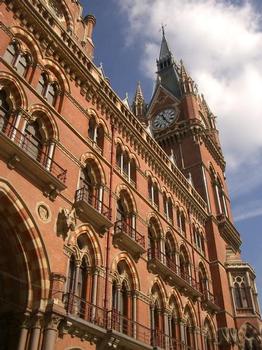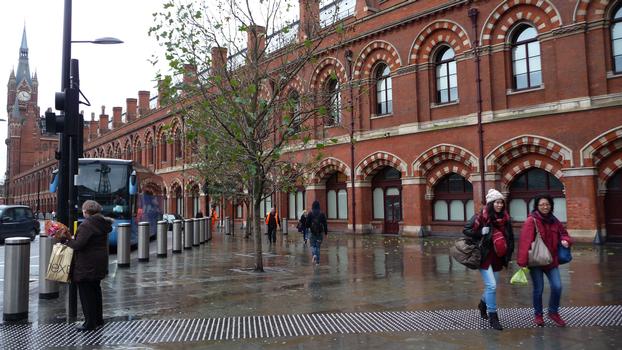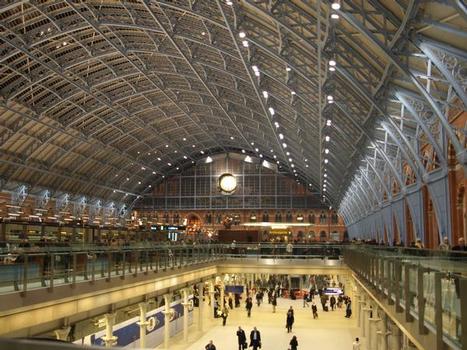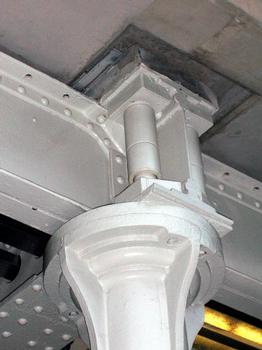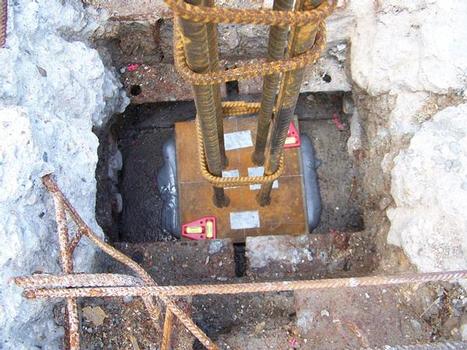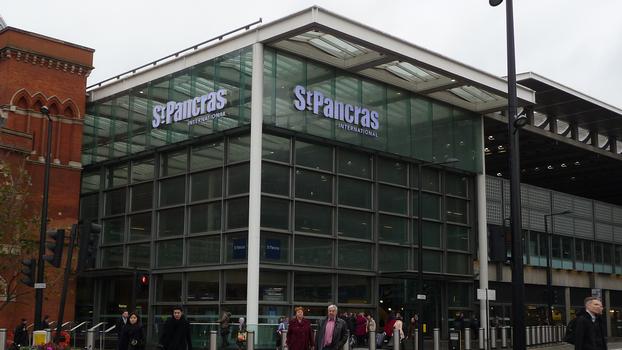General Information
| Completion: | 1868 |
|---|---|
| Status: | in use |
Project Type
| Structure: |
Tied-arch roof |
|---|---|
| Function / usage: |
Railroad (railway) station |
Location
| Location: |
Camden, London, England, United Kingdom |
|---|---|
| Part of: | |
| Above of: |
Saint Pancras Thameslink Station (2007)
|
| Connects to: |
King's Cross Saint Pancras Underground Station
Saint Pancras Renaissance Hotel London (1876) |
| Coordinates: | 51° 31' 51.45" N 0° 7' 33.28" W |
Technical Information
Dimensions
| covered area | 17 000 m² | |
| span | 73 m | |
| number of columns | 720 |
Materials
| roof |
wrought iron
|
|---|---|
| columns |
cast iron
|
| floor beams |
wrought iron
|
Chronology
| 1869 | 10 railway tracks on main floor within arch roof. Space below used for transit of beer into London. |
|---|---|
| 1935 | Abutting hotel converted into offices. |
| 2007 | Six Channel Tunnel railway tracks on main floor level. UK trains relocated to level below. Hotel restored to original use. |
Excerpt from Wikipedia
St Pancras railway station (/ˈpæŋkrəs/), also known as London St Pancras and officially since 2007 as St Pancras International, is a central London railway terminus on Euston Road in the London Borough of Camden. It is the terminus for Eurostar continental services from London via High Speed 1 and the Channel Tunnel to Belgium, France and the Netherlands. It provides East Midlands Trains services to Corby, Sheffield and Nottingham on the Midland Main Line, Southeastern high-speed trains to Kent via Ebbsfleet International and Ashford International, and Thameslink cross-London services to Bedford, Peterborough, Brighton and Gatwick Airport. It stands between the British Library, the Regent's Canal and King's Cross railway station, with which it shares a London Underground station, King's Cross St. Pancras.
The station was constructed by the Midland Railway (MR), which had an extensive network across the Midlands and the North of England, but no dedicated line into London. After rail traffic problems following the 1862 International Exhibition, the MR decided to build a connection from Bedford to London with their own terminus. The station was designed by William Henry Barlow and constructed with a single-span iron roof. Following the station's opening on 1 October 1868, the MR constructed the Midland Grand Hotel on the station's façade, which has been widely praised for its architecture and is now a Grade I listed building along with the rest of the station.
By the 1960s, St Pancras was surplus to requirements and services were diverted to King's Cross and Euston but there was fierce opposition to its proposed closure and demolition of the station and hotel. The station was reinvented in the late 20th century as the terminal for the Channel Tunnel Rail Link in an urban regeneration plan across East London. The complex underwent a £800 million refurbishment which was opened by Queen Elizabeth II in November 2007. A security-sealed terminal area was constructed for Eurostar services to continental Europe via High Speed 1 and the Channel Tunnel, with platforms for domestic trains to the north and south-east of England. The restored station has 15 platforms, a shopping centre, and a coach facility. St Pancras is owned by London and Continental Railways (LCR) and managed by Network Rail (High Speed), a subsidiary of Network Rail.
Location
St Pancras is at the southern end of the London Borough of Camden on a site orientated north/south, deeper than it is wide. The south is bounded by Euston Road (part of the London Inner Ring Road), and its frontage is the St Pancras Renaissance Hotel, while the west is bounded by Midland Road which separates it from the British Library and the east by Pancras Road which separates it from King's Cross station. The British Library is on the former goods yard site.
Behind the hotel, the train shed is elevated 5 m (17 ft) above street level and the area below forms the station undercroft. The northern half of the station is mainly bounded to the east by Camley Street, with Camley Street Natural Park across the road. To the north-east is King's Cross Central, formerly known as the Railway Lands, a complex of intersecting railway lines crossed by several roads and the Regent's Canal.
History
Background
The train shed under construction in 1868
The station's name comes from the St. Pancras neighbourhood, which originates from the fourth-century Christian boy martyr Pancras of Rome. The station was commissioned by the Midland Railway (MR), who had a network of routes in the Midlands, and in south and west Yorkshire and Lancashire but no route of its own to London. Before 1857 the MR used the lines of the L&NWR for trains into the capital; subsequently the company's Leicester and Hitchin Railway gave access to London via the Great Northern Railway (GNR).
In 1862, traffic for the second International Exhibition suffered extensive delays over the stretch of line into London over the GNR's track; the route into the city via the L&NWR was also at capacity, with coal trains causing the network at Rugby and elsewhere to reach effective gridlock. This was the stimulus for the MR to build its own line to London from Bedford, which would be just under 50 miles (80 km) long. Samuel Carter was solicitor for the parliamentary bill, which was sanctioned in 1863.
Design and construction
The station was designed by William Henry Barlow and constructed on a site that had previously been a slum called Agar Town. Though coal and goods were the main motivation to build the station, the Midland realised the prestige of having a central London terminus, and decided it must have a front on Euston Road. The company purchased the eastern section of land on the road's north side owned by Earl Somers.
The approaching line to the station crossed the Regent's Canal at height allowing the line reasonable gradients; this resulted in the level of the line at St Pancras being 20 ft (6.1 m) above the ground level. Initial plans were for a two or three span roof with the void between station and ground level filled with spoil from tunnelling to join the Midland Main Line to the St. Pancras branch. Instead, due to the value of the land in such a location the lower area was used for freight, in particular beer from Burton.[a] As a result, the undercroft was built with columns and girders, maximising space, set out to the same plans as those used for beer warehouses, and with a basic unit of length that of a beer barrel.
The contract for the construction of the station substructure and connecting lines was given to Messrs. Waring, with Barlow's assistant Campion as supervisor. The lower floor for beer warehousing contained interior columns 15 ft (4.57 m) wide, and 48 ft (14.63 m) deep carrying girders supporting the main station and track. The connection to the Widened Lines (St. Pancras branch) ran below the station's bottom level, in an east-to-west direction.
To avoid the foundations of the roof interfering with the space beneath, and to simplify the design, and minimise cost, it was decided to construct a single span roof, with cross ties for the arch at the station level. The arch was sprung directly from the station level, with no piers. Additional advice on the design of the roof was given to Barlow by Rowland Mason Ordish. The arches' ribs had a web depth of 6 ft (1.8 m), mostly open ironwork. The span width, from wall to wall was 245 ft 6 in (74.83 m), with a rib every 29 ft 4 in (8.94 m) The arch was a slightly pointed design, with a reduced radius of curvature at the springing points. The Butterley Company was contracted to construct the arches. The total cost of the 24 rib roof and glazing was over £53,000, of which over half was for the main ribs. The cost of the gable end was a further £8,500.
The single-span overall roof was the largest such structure in the world at the time of its completion. The materials used were wrought iron framework of lattice design, with glass covering the middle half and timber (inside)/slate (outside) covering the outer quarters. The two end screens were glazed in a vertical rectangular grid pattern with decorative timber cladding around the edge and wrought iron finials around the outer edge. It was 689 feet (210.01 m) long, 240 feet (73.15 m) wide, and 100 feet (30.48 m) high at the apex above the tracks. At the time of opening, it was the world's largest unsupported station roof.
Local services began running to the Metropolitan Railway junction underneath the terminus on 13 July 1868. The station itself opened to the public on 1 October. The first service was an overnight mail train from Leeds.
Early services
St Pancras was built during a period of expansion for the MR, as the major routes to Manchester, Nottingham, Sheffield and Carlisle opened during this time. By 1902, there were 150 trains arriving and leaving the station daily, though this figure was far less than Waterloo or Liverpool Street. As well as Midland services, the Great Eastern Railway (GER) used St Pancras as a "West End" terminus for trains to Great Yarmouth, Norwich, Lowestoft between 1870 and 1917. At the turn of the 20th century, St Pancras also had a faster service to Cambridge than King's Cross, at 71 minutes. GER services were suspended because of World War I and never resumed.
The London, Tilbury and Southend Railway (LTSR) began offering boat train services from St Pancras from 9 July 1894, following the opening of the Tottenham and Forest Gate Railway. The trains ran from St Pancras to Tilbury via South Tottenham and Barking. Tilbury Docks then provided a connection to Australia and Scandinavia. The following year, the LTSR began a service from St Pancras to Southend Central. Boat trains continued to run from St Pancras until 1963, after which they were moved to Liverpool Street and Fenchurch Street.
Grouping, nationalisation and privatisation
The Railways Act of 1921 forced the merger of the Midland with the London and North Western Railway (L&NWR) into the London, Midland and Scottish Railway (LMS), and the LMS adopted the LNWR's (the "Premier Line") Euston station as its principal London terminus. The Midland Grand Hotel was closed in 1935, and the building was subsequently used as offices for British Railways. During World War II, bombing inflicted damage on the train shed, which was only partially reglazed after the war. On the night of 10–11 May 1941 a bomb fell onto the station floor at platform 3, exploding in the beer vaults underneath. The station was not significantly damaged, but was closed for eight days, with platforms 2–3 remaining closed until June. In 1947 the St. Pancras junction was relaid with prefabricated trackwork, along with associated changes to the signalling system.
On the creation of British Railways (BR) in 1948, St Pancras received a significant investment after neglect by the LMS. Destinations included the London area services to North Woolwich, St Albans and Bedford. Long-distance trains reached Glasgow, Leeds, Nottingham, Sheffield and Manchester, with famous named trains including The Palatine to Manchester, The Thames-Clyde Express to Glasgow, and The Master Cutler to Sheffield (transferred from King's Cross in 1966, which itself had transferred from Marylebone eight years earlier).
On 7 October 1957, the signalling at St Pancras was upgraded, replacing the three original boxes with a power box controlling 205 route switches and 33 points over a network of 1,400 relays. From 1960 to 1966, electrification work on the West Coast Main Line between London and Manchester saw a new Midland Pullman from Manchester to St Pancras. These trains and those to Glasgow were withdrawn following the completion of the rebuilding of Euston and the consolidation of these services.
By the 1960s, St Pancras was seen as redundant, and several attempts were made to close it and demolish the hotel (by then known as St Pancras Chambers). These attempts provoked strong and successful opposition, with the campaign led by the later Poet Laureate, John Betjeman. Jane Hughes Fawcett with the Victorian Society was instrumental in its preservation, and was dubbed "the furious Mrs. Fawcett" by British rail officials. Many of the demonstrators had witnessed the demolition of the nearby Euston Arch a few years previously, and were strongly opposed to the distinctive architecture of St Pancras suffering the same fate. The station became Grade I listed building in November 1967, preventing any drastic modifications. The plans were scrapped by BR in December 1968, realising that it was more cost-effective to modernise the hotel instead, though they disliked owning it.
In the 1970s, the train shed roof was in danger of collapse, and the newly appointed Director of Environment Bernard Kaukas persuaded the company to invest £3m to save it. In 1978, a Private Eye piece said that British Rail really wanted to demolish St Pancras but were opposed by "a lot of long-haired sentimentalists" and "faceless bureaucrats" and praised the office blocks that replaced the Euston Arch.
After the sectorisation of British Rail in 1986, main-line services to the East Midlands were provided by the InterCity sector, with suburban services to St Albans, Luton and Bedford by Network SouthEast. In 1988 the Snow Hill tunnel re-opened resulting in the creation of the Thameslink route and the resultant diversion of the majority of suburban trains to the new route. The station continued to be served by trains running on the Midland main line to Leicester, Nottingham and Sheffield, together with a few suburban services to Bedford and Luton. These constituted only a few trains an hour and left the station underused.
Following the privatisation of British Rail, the long-distance services from St Pancras were franchised to Midland Mainline, a train operating company owned by National Express, starting on 28 April 1996. The few remaining suburban trains still operating into St Pancras were operated by the Thameslink train operating company, owned by Govia, from 2 March 1997.
A small number of trains to and from Leeds were introduced, mainly because the High Speed Train sets were maintained there and were already running empty north of Sheffield. During the 2000s major rebuild of the West Coast Main Line, St Pancras again temporarily hosted direct and regular inter-city trains to Manchester, this time via the Hope Valley route (via the Dore South curve) under the title of Project Rio.
New role
The original plan for the Channel Tunnel Rail Link (CTRL) involved a tunnel from south-east of London to an underground terminus in the vicinity of King's Cross. However, a late change of plan, principally driven by the then Secretary of State for the Environment Michael Heseltine's desire for urban regeneration in east London, led to a change of route, with the new line approaching London from the east. This opened the possibility of reusing St Pancras as the terminus, with access via the North London Line, which crosses the throat of the station.
The idea of using the North London line was rejected in 1994 by the transport secretary, John MacGregor, as "difficult to construct and environmentally damaging". However, the idea of using St Pancras station as the terminus was retained, albeit now linked by 12.4 miles (20 km) of new tunnels to Dagenham via Stratford.
London and Continental Railways (LCR), created at the time of British Rail privatisation, was selected by the government in 1996 to reconstruct St Pancras, build the CTRL, and take over the British share of the Eurostar operation. LCR had owned St Pancras station since privatisation to allow the station to be redeveloped. Financial difficulties in 1998, and the collapse of Railtrack in 2001, caused some revision of this plan, but LCR retained ownership of the station.
The design and project management of reconstruction was undertaken on behalf of LCR by Rail Link Engineering (RLE), a consortium of Bechtel, Arup, Systra and Halcrow. The original reference design for the station was by Nick Derbyshire, former head of British Rail's in-house architecture team. The master plan of the complex was by Foster and Partners, and the lead architect of the reconstruction was Alistair Lansley, a former colleague of Nick Derbyshire recruited by RLE.
To accommodate 300-metre+ Eurostar trains, and to provide capacity for the existing trains to the Midlands and the new Kent services on the high-speed rail link, the train shed was extended a considerable distance northwards by a new flat-roofed shed. The station was initially planned to have 13 platforms under this extended train shed. East Midlands services would use the western platforms, Eurostar services the middle platforms, and Kent services the eastern platforms. The Eurostar platforms and one of the Midland platforms would extend back into the Barlow train shed. Access to Eurostar for departing passengers would be via a departure suite on the west of the station, and then to the platforms by a bridge above the tracks within the historic train shed. Arriving Eurostar passengers would leave the station by a new concourse at its north end.
This original design was later modified, with access to the Eurostar platforms from below, using the station undercroft and allowing the deletion of the visually intrusive bridge. By dropping the extension of any of the Midland platforms into the train shed, space was freed up to allow wells to be constructed in the station floor, which provided daylight and access to the undercroft.
The reconstruction of the station was recorded in the BBC Television documentary series The Eight Hundred Million Pound Railway Station broadcast as six 30-minute episodes between 13‒28 November 2007.
Rebuilding
By early 2004, the eastern side of the extended train shed was complete, and the Barlow train shed was closed to trains. From 12 April 2004, Midland Mainline trains terminated at an interim station occupying the eastern part of the extension immediately adjacent to the entrance.
As part of the construction of the western side of the new train shed that now began, an underground "box" was constructed to house new platforms for Thameslink, which at this point ran partially under the extended station. In order for this to happen, the existing Thameslink tunnels between Kentish Town and King's Cross Thameslink were closed between 11 September 2004 and 15 May 2005 while the works were carried out. Thameslink services from the north terminated in the same platforms as the Midland Main Line trains, while services from the south terminated at King's Cross Thameslink.
When the lines were re-opened, the new station box was still only a bare concrete shell and could not take passengers. Thameslink trains reverted to their previous route but ran through the station box without stopping. The budget for the Channel Tunnel Rail Link works did not include work on the fitting out of the station, as these works had originally been part of the separate Thameslink 2000 works programme. Despite lobbying by rail operators who wished to see the station open at the same time as St Pancras International, the Government failed to provide additional funding to allow the fit out works to be completed immediately following the line blockade. Eventually, on 8 February 2006, Alistair Darling, the Secretary of State for Transport, announced £50 million funding for the fit-out of the station, plus another £10–15 million for the installation of associated signalling and other lineside works.
The fit-out works were designed by Chapman Taylor and Arup (Eurostar) and completed by ISG Interior Plc Contractors collaborating with Bechtel as Project Managers. The client was London and Continental Railways who were advised by Hitachi Consulting.
In 2005, planning consent was granted for a refurbishment of the former Midland Grand Hotel building, with plans to refurbish and extend it as a hotel and apartment block. The newly refurbished hotel opened to guests on 21 March 2011 with a grand opening ceremony on 5 May.
By the middle of 2006, the western side of the train shed extension was completed. The rebuilding cost was in the region of £800 million, up from an initial estimate of £310 million.
International station
In early November 2007, Eurostar conducted a testing programme in which some 6000 members of the public were involved in passenger check-in, immigration control and departure trials, during which the "passengers" each made three return journeys out of St Pancras to the entrance to the London tunnel. On 4 September 2007, the first test train ran from Paris Gare du Nord to St Pancras. Children's illustrator Quentin Blake was commissioned to provide a huge mural of an "imaginary welcoming committee" as a disguise for one of the remaining ramshackle Stanley Building South immediately opposite the station exit.
St Pancras was officially re-opened as St Pancras International, and the High Speed 1 service was launched on 6 November 2007 by Queen Elizabeth II and the Duke of Edinburgh. Services were extended to Rotterdam and Amsterdam in April 2018.
During an elaborate opening ceremony, actor Timothy West, as Henry Barlow, addressed the audience, which was also entertained by the Royal Philharmonic Orchestra and the singers Lemar and Katherine Jenkins. In a carefully staged set piece, the first Class 395 train and two Class 373 trains arrived through a cloud of dry ice in adjacent platforms within seconds of each other. During the ceremony, Paul Day's large bronze statue The Meeting Place was also unveiled. At a much smaller ceremony on 12 November 2007, the bronze statue of John Betjeman by sculptor Martin Jennings was unveiled by Betjeman's daughter, the author Candida Lycett Green. Public service by Eurostar train via High Speed 1 started on 14 November 2007. In a small ceremony, station staff cut a ribbon leading to the Eurostar platforms. In the same month, services to the East Midlands were transferred to a new franchisee, East Midlands Trains. The low-level Thameslink platforms opened on 9 December 2007, replacing King's Cross Thameslink.
St Pancras has retained a reputation of having one of the most recognisable facades of all the London termini, and known as the "cathedral of the railways". In Britain's 100 Best Railway Stations by Simon Jenkins, the station was one of only ten to be awarded five stars. The station has bilingual signs in French and English, one of the few in England to do so.
Services
St Pancras contains four groups of platforms on two levels, accessed via the main concourse at ground level. The below-surface group contains through platforms A and B, and the upper level has three groups of terminal platforms: domestic platforms 1–4 and 11–13 on each side of international platforms 5–10. Platforms A & B serve Thameslink, 1–4 connect to the Midland Main Line, while platforms 11–13 lead to High Speed 1; there is no connection between the two lines, except for a maintenance siding outside the station. There are also a variety of shops and restaurants within the station concourse.
The station is the London terminus for Eurostar's high-speed trains to Paris, Brussels, Amsterdam and Lille via the Channel Tunnel. It is also the terminus for East Midlands services from London to Derby, Leicester, Nottingham, Sheffield, and smaller towns en route. Thameslink trains on the cross-London Thameslink route call at platforms beneath the main station, south to Gatwick Airport and Brighton and north to Luton Airport Parkway for Luton Airport and Bedford. High-speed domestic services to Kent, run by Southeastern, depart on the same level as Eurostar & East Midlands Trains.
The terminal is one of relatively few railway stations in England to feature multilingual signage in English and French. In March 2014, the station's public relations team commissioned a study of mispronounced words, reportedly as a result of passengers referring to the station as "St Pancreas".
Platform layout
The longer international platforms, used by Eurostar, extend into Barlow's train shed, whilst the other platforms terminate at the southern end of the 2005 extension. The international platforms do not occupy the full width of the Barlow train shed, and sections of the floor area have been opened up to provide natural light to the new ground-level concourse below. Eurostar's arrival and departure lounges lie below these platforms, adjacent to The Arcade, a concourse fashioned from the original station undercroft which runs along the western length of the Barlow train shed. The southern end of The Arcade links to the western ticket hall of King's Cross St Pancras tube station.
Access to the East Midlands Trains platforms are via the northern end of The Arcade, while the Thameslink and domestic High-Speed platforms are reached via a street-level concourse where the old and new parts of the station meet. The main pedestrian entrance is at the eastern end of this concourse, where a subway enables pedestrians to reach King's Cross station and the northern ticket hall of the tube station.
Domestic services
East Midlands Trains
Two Class 222 Meridian diesel multiple units and a Class 43 HST diesel set operated by East Midlands Trains, at the Midland Main Line platforms
Since 2007, platforms 1–4 have been the southern terminus for Midland Main Line trains operated by East Midlands Trains to/from the East Midlands and Yorkshire, including Leicester, Corby, Nottingham, Kettering, Derby and Sheffield. Occasional trains also run to Melton Mowbray, Lincoln, Leeds, York and Scarborough.
Service pattern Destination Calling at Main stock Journey time XX:02 Sheffield Leicester, Derby, Chesterfield 222 2 h 1 min XX:05 Nottingham Luton Airport Parkway, Bedford, Wellingborough, Kettering, Market Harborough, Leicester, Loughborough, Beeston 222 1 h 52 min XX:31 Sheffield Leicester, Loughborough, East Midlands Parkway, Long Eaton, Derby, Chesterfield 222 2 h 15 min XX:34 Nottingham Market Harborough, Leicester, East Midlands Parkway HST 1 h 40 min XX:47 Corby Luton, Bedford, Wellingborough, Kettering 222 1 h 10 min
Thameslink
As part of the Thameslink Programme, St Pancras International gained platforms on the Thameslink route, replacing King's Cross Thameslink to the south-east. In line with the former station, the Thameslink platforms are designated A and B. The new platforms have met with some criticism for the length of the walking route to the underground as compared with King's Cross Thameslink. The Thameslink Programme involves the introduction of 12-car trains across the enlarged Thameslink network. As extending the platforms at King's Cross Thameslink was thought to be impractical (requiring alterations to Clerkenwell No 3 tunnel and the Circle/Hammersmith & City/Metropolitan Underground lines, which would be extremely disruptive and prohibitively expensive), it was decided to build new Thameslink platforms under St Pancras.
The Thameslink platforms serve trains to Bedford, Luton, St Albans City, Cambridge and Peterborough in the north, and Wimbledon, Sutton, East Croydon, Gatwick Airport and Brighton in the south.
Southeastern
Southeastern runs high-speed Class 395 trains on High Speed 1 to Kent and the South East, to Faversham, Margate, Ramsgate, Canterbury West, Dover Priory, Folkestone Central, Ashford, Ebbsfleet International and other destinations in Kent.
The first domestic service carrying passengers over High Speed 1 ran on 12 December 2008, to mark one year before regular services were due to begin. This special service, carrying various dignitaries, ran from Ashford International to St Pancras. Starting in June 2009, Southeastern provided a preview service between St Pancras and Ebbsfleet, extending to Ashford International during peak hours. In September, Southeastern extended the peak-time services to Dover and Ramsgate. The full service began on 13 December.
Departures
Service pattern Destination Calling at Journey time XX:12 Dover Priory Stratford International, Ebbsfleet International, Ashford International, Folkestone West, Folkestone Central 1 h 08 min XX:25 Faversham Stratford International, Ebbsfleet International, Gravesend, Strood, Rochester, Chatham, Gillingham (Kent), Rainham (Kent), Sittingbourne 1 h 08 min XX:37 Margate Stratford International, Ebbsfleet International, Ashford International, Canterbury West, Ramsgate, Broadstairs 1 h 28 min XX:55 Faversham Stratford International, Ebbsfleet International, Gravesend, Strood, Rochester, Chatham, Gillingham (Kent), Rainham (Kent), Sittingbourne 1 h 08 min
Arrivals
Service pattern Departure Calling at Journey time XX:28 Faversham Sittingbourne, Rainham (Kent), Gillingham (Kent), Chatham, Rochester, Strood, Gravesend, Ebbsfleet International, Stratford International 1 h 11 min XX:44 Dover Priory Folkestone Central, Folkestone West, Ashford International, Ebbsfleet International, Stratford International 1 h 07 min XX:53 Margate Broadstairs, Ramsgate, Canterbury West, Ashford International, Ebbsfleet International, Stratford International 1 h 28 min XX:58 Faversham Sittingbourne, Rainham (Kent), Gillingham (Kent), Chatham, Rochester, Strood, Gravesend, Ebbsfleet International, Stratford International 1 h 11 min
Olympic Javelin service
During the 2012 Summer Olympics in London, St Pancras was the Central London terminus of the Olympic Javelin service, a seven-minute shuttle between Central London and Stratford International station for the London Olympic Park.
International services
Seventeen pairs of Eurostar trains to and from Paris Gare du Nord every day, ten pairs of trains to and from Bruxelles-Midi/Brussel-Zuid for Brussels and the European Union de facto capital, and one train to and from Marne-la-Vallée for Disneyland Resort Paris. Extra services run to Paris on Fridays and Sundays, with a reduced service to Brussels at weekends. Additional weekend leisure-oriented trains run to the French Alps during the skiing season, and to Marseille via Lyon and Avignon in the summer. It also serves as the terminus for services to Amsterdam from Spring 2018. Trains call at a mix of four intermediate stations (Ebbsfleet International, Ashford International, Calais-Fréthun and Lille-Europe), with some running non-stop. Non-stop trains take 2 hours 15 minutes to Paris, and just under 1 hour 50 minutes to Brussels, other trains taking 5 or 10 minutes longer depending on whether they make one or two stops.
St Pancras International is one of four railway stations in the UK with juxtaposed immigration control facilities set up by the French Border Police to clear passengers for entry into France and the rest of the Schengen Area prior to boarding the trains. Passengers do not need any further immigration or passport checks after entering the main departure gates, or at the corresponding gate at the other end on return journeys, as they are cleared by the UK Border Force.
Accidents and incidents
On 17 February 1918 a German Gotha aircraft dropped five bombs one of which destroyed the roof of the station's ornate booking hall and killed 20 people. The station was also bombed in World War II, including a parachute mine damaging the roof on 15–16 October 1940, and a bomb exploding in the beer vaults underneath Platform 3 on 10–11 May 1941.
On 20 July 1959, a locomotive overran a signal and consequently crashed into Dock Junction Signal Box. As a result, trains had to be hand-signalled in and out of St Pancras for several days.
Text imported from Wikipedia article "St Pancras railway station" and modified on 22 July 2019 under the CC-BY-SA 3.0 license.
Participants
- William Henry Barlow (engineer)
- Rowland Mason Ordish (engineer)
Relevant Web Sites
Relevant Publications
- (1997): L'architecture et les ingénieurs. Deux siècles de réalisations. Moniteur, Paris (France), pp. 47.
- (1997): L'art de l'ingénieur. constructeur, entrepeneur, inventeur. Éditions du Centre Georges Pompidou, Paris (France), pp. 433.
- CTRL Next Stop St Pancras. In: New Civil Engineer (28 June 2001).
- (1870): Description of the St Pancras Station and roof, Midland Railway. In: Minutes of the Proceedings of the Institution of Civil Engineers, v. 30, n. 1870-2 ( 1870), pp. 78-93.
- : An Engineer's Guide to Interesting Structures in London. Arranged for Walking Tours. pp. 14-15.
- About this
data sheet - Structure-ID
20000399 - Published on:
12/09/1999 - Last updated on:
10/01/2015

